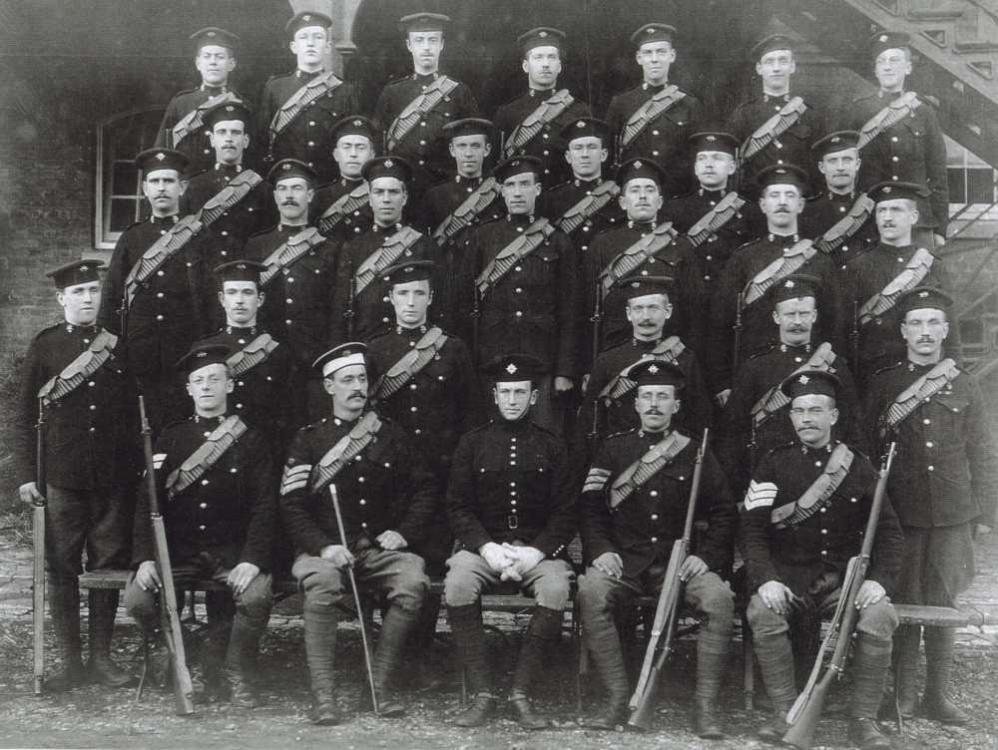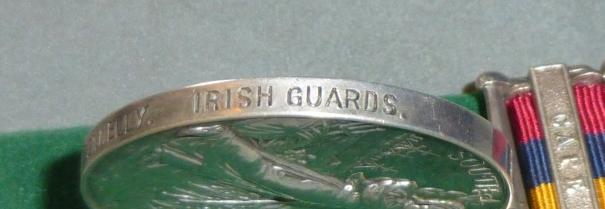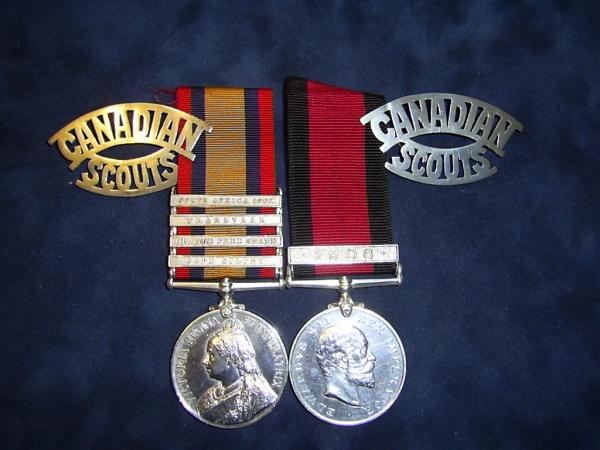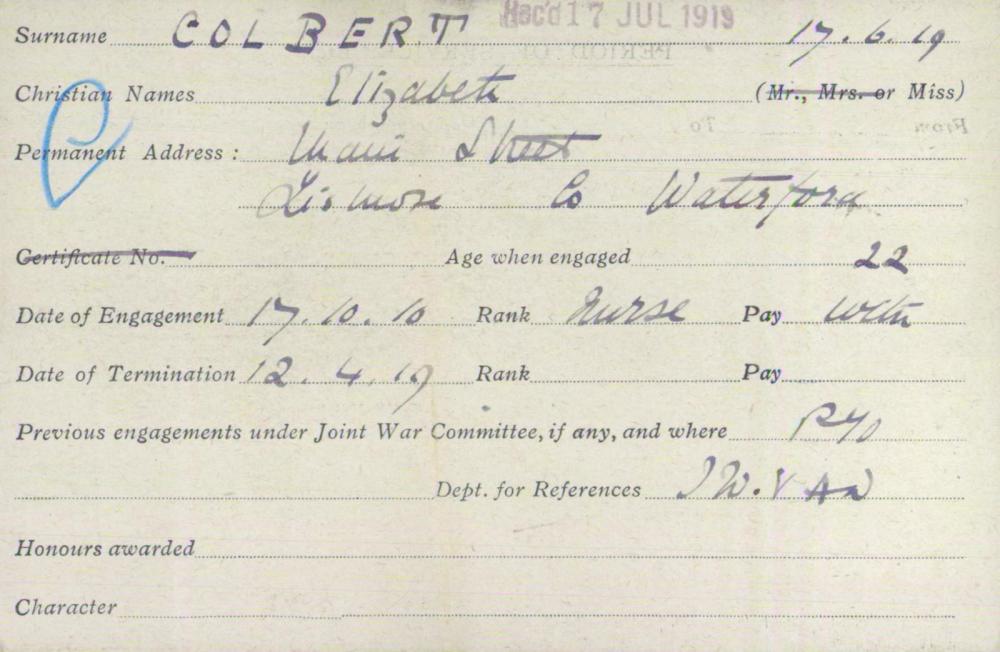-
Posts
2,111 -
Joined
-
Last visited
-
Days Won
11
Content Type
Profiles
Forums
Blogs
Gallery
Events
Store
Everything posted by QSAMIKE
-

My British Collection
QSAMIKE replied to Wessel Gordon's topic in Great Britain: Orders, Gallantry, Campaign Medals
Sorry to say but the ribbons on the 1939/45 Star, Africa Star, Pacific Star are on the medals backwards..... Mike -

My British Collection
QSAMIKE replied to Wessel Gordon's topic in Great Britain: Orders, Gallantry, Campaign Medals
The Victoria Cross followed by the George Cross has preference over everything…….. -

J.A. Morrison S.A.C.
QSAMIKE replied to medalnet's topic in Great Britain: Orders, Gallantry, Campaign Medals
This medal was issued to a Canadian..... He has changed his rank and added the "E" which was his squadron...… His full name is John Alexander...… His rank should be 3rd Class Trooper...…. Mike -

Placement of the MOH on a ribbon bar
QSAMIKE replied to Wessel Gordon's topic in United States of America
Interesting that the Colonel, 3rd picture looks like he volunteered to serve in the Canadian Army before the US got into the war as he is wearing Canadian ribbons, backwards but he is still wearing them...... Mike -

The Irish Guards.
QSAMIKE replied to leigh kitchen's topic in Great Britain: Militaria: Badges, Uniforms & Equipment
Here is one of the first Irish Guards members..... His enlistment date was the 22nd of April, 1900 and he was sent to South Africa to serve in the Boer War within 3 months..... A few pictures for your enjoyment..... Irish Guards Mounted Infantry, No. 2 Company, 2 Section His Medal and his Bed Plate Mike -
GOOD EVENING GENTLEMEN...... I Have decided to take on the project of compiling a list of all the existing Queen's South Africa Medals either in singles or in groups named to..... THE CANADIAN SCOUTS I would ask the assistance of all members of the forum if they can provide me with the following information..... 1. Name, Rank and Regimental Number (Note: Some medals were issued without a Number). 2. Style of Name Unitt: CAN. SCOUTS, CANAD'N SCOUTS, CANADIAN SCOUTS 3. Bars on the medal. 4. If part of a Group the other medals in the group. 5. Country of Location. I do not want any personal information just Country. All information will be kept confidential and I may possibly be able to pass on some information to you...... Thank you in advance for any assistance that you can provide..... Mike
-
This has been a long long long running discussion (argument) to clean or not to clean original medals...… The only thing that I will say is I have never seen a Regimental Sergeant Major approve of dirty medals (or boots) on parade...… True 99.9% of modern medals are made in a way that they never need cleaning..... Mike
-
Found in FMP...…. Mike First name(s) Elizabeth Last name Colbert Year 1916 Birth year - Rank V.A.D. Nurse Address Main Street, Lismore. County Waterford County as transcribed Co Waterford Country Ireland Engagement date 18/10/1916 Pay at engagement £20. p.a. Termination date 29/08/1919 Rank at termination V.A.D. Nurse Pay at termination £22.10.p.a. Hours worked whole time Commission St. John Reserve Detachment. Duties V.A.D. Nurse at Bristol, transferred Salonika. April.1918. Addtional information Purple Stamp: British Red Cross Society & Order of St. John. Joint War Committee, Leinster, Munster & Connaught. Archive British Red Cross Source View the Source Record Record set British Army, British Red Cross Society Volunteers 1914-1918
-
CORP. / LIEUT. F. SCHISSLER, MC, MM, 75TH BATTALION C.E.F. Regimental Number: 139226 Name: Frank Schiller Date of Birth: August 3rd, 1890 (25) Place of Birth: Victoria Harbour, Ontario, Canada Trade / Calling: Office Clerk Date of Enlistment: August 6th, 1915 Unit: 75th Mississauga Battalion C.E.F. (Later Central Ontario Regiment) Served with: 4th Canadian Division Award: Military Medal, London Gazette, 11th May, 1917 Page 4602, (Vimy Ridge) No Citation Promoted Lieutenant: Canada Gazette, Page 3616 Award: Military Cross, Supplement London Gazette, # 31680, 10th December 1919. Citation: For great gallantry in and around Bourlon Wood and North of Cambrai 27th / 30th September 1918. His Company Commander being killed he assumed Command and led his Company excellently. On the 30th again he led his Company with great dash at which time he was severly wounded. Battle of the Canal du Nord and Bourlon Wood WAR DIARY – 75th BATTALION – 26th September / 1st October 1918 26th September 1918 Clear, Bright, Sunny Day. Advance parties sent forward early in the morning to look over the routs and assembly position for the coming operation. All packs and surplus stores were turned in, and final preparations made for the attack. Bourlon Wood the chief objective of the Brigade in the up coming operation can be plainly seen from here. The good news from Palestine and Macedonia has had a very cheering effect on the men. At 11:30 pm the Battalion moved off for its assembly position in the order “A”, “B”, “D”, “C” and Headquarters, the Transport and Tactical Platoon moving to points at the northern outskirts of QUEANT. About 9.00 pm the rain commenced to fall heavily which made the roads very muddy and walking very disagreeable. The main roads were jammed with traffic, guns, ammunition and troops being hurried forward for the attack in the morning. Great preparations have been made for this attack, especially the artillery barrage. A noticeable feature is that a standard gauge railway has been repaired and placed in operation to a point some distance East of QUEANT, and under direct enemy observation. 27th September 1918 The Battalion reached its assembly position just North Pronville and Inchy-en-Artois, at 3:50 am. Before morning the rain had cleared off and the morning broke clear and bright. At 5:20 am a tremendous barrage opened up, heralding the commencement of the attack. The Battalion started to move forward at 6:20, in the order A-B-D-C, H.Q. It was noticeable that there was very little retaliation on the back areas from the enemy, in answer to our bombardment. The Battalion moved along close to the road, past the Northern outskirts of Inchy, and on to the bank of the Canal-du-Nord, arriving there at 8:10. After passing Inchy the first enemy shell fire was encountered, mostly heavy H.E. And Gas Shells. At 7:00 am the wounded and prisoners began to flow to the rear areas and we were told that everything was going well. Our 18 pounders had arrived at the Canal bank and were in action at the time of our arrival there. At 10:10 am the Battalion moved forward, across the Canal, due East toward Bourlon Wood, At the same time the 54th and 102nd Battalions went through the 12th Brigade, with the 87th Battalion in support, and we following in reserve. The objective of the 11th Brigade was the railway just East of Bourlon Wood. The Battalion followed up the advance in the order H.Q., “A” and “B” Companies with “D” and “C” Companies following. “A” and “B” Companies took up position in Trex Street, “C” and “D” Companies in Edward Street, with Battalion H.Q. In a pill box just ahead of the sunken road in E.17.O.85.80., where they remained until 3.00 p.m. By this time the Battalions had pushed ahead to within 500 yards of the Eastern edge of Bourlon Wood. At 3.00 pm, “A” and “B” Companies moved forward to support the 54th Battalion and about 7 p.m. Went over with the 54th Battalion and established a line in the Eastern outskirts of the wood. About the same time “C” and “D” Companies went forward to reinforce the 102nd Battalion and took up a position in the wood F.19.b. The 102nd H.Q. Was located in the same pill box as out H.Q., and owing to the O.C. And Adjutant of the 102nd Battalion being wounded, Colonel Thompson assumed command of that Unit, Major Bailey taking command of the 75th. At dusk the enemy heavily counter-attacked the 102nd Battalion which was reinforced by our two companies. This attack was met and completely repulsed. “C” Company was then ordered to swing to the left through the wood and mop up the sunken road running East through F.14. This was carried out without casualties. The line was then consolidated and held until the morning. Our casualties for the day were Capt. M. A. Neelon, in command of “A” Company, killed during the attack with the 54th Battalion, at 7 pm. - Lieut. W. T. Hall, Signaling Officer, killed at Battalion Headquarters – 3 other ranks killed and 30 wounded. 28th September 1918 At dawn the 3rd Division went through our Brigade, the 43rd Battalion passing through us, under cover of a heavy barrage. “A” and “B” Companies fell back to the sunken road South of Bourlon, where they remained until 3 p.m., when the two Companies and Battalion H.Q. Assembled in E.5.c and d.. in the open. At 5 pm they were joined by “C” and “D” Companies, and once more the Battalion was together and organized as a Unit. At this stage of the operations the enemy shell fire, particularly on the back areas and Bourlon, had practically dies out. In the meantime our guns had been pushed forward, many 18 and 60 pounders taking up positions on the North and South flanks of the Wood. During the day the company kitchens had moved up and supplied meals for the men. The Battalion transport lines moved up early in the day to a point about 800 yards south of Quarry Wood, where they remained until night and then moved up to a position a few hundred yards to the East of Battalion Headquarters, just at the edge of Bourlon village. No casualties were suffered during the day. The night was very clear and moonlight. Many enemy bombing planes came over and although a number of bombs were dropped in our area, no casualties were suffered. 29th September 1918 At 3:45 am a message was received from Brigade H.Q. That the 12th Brigade would attack to the North of Sailly at 8 am, the 11th Brigade to support the attack and exploit if the 12th Brigade was successful. During the night many batteries had taken up position well forward and at 8 am, a fairly heavy barrage opened. At 7 am the Battalion had moved forward and taken up a position in the Brigade assembly area near Farm des Lilse. The 12th Brigade met with very stiff opposition and were unable to take their objective. The Battalion was therefore not called upon to follow up the attack, except that the Battalion Scouts and Observes went over with the 12th Brigade to keep in touch with the situation. The four Companies had moved forward with the attack, to a trench just South of Haynecourt. They were heavily shelled here and many casualties resulted, among them Lieut. F. E. Odlum, who was wounded. In the evening they moved back to their original position at Farm des Lilse, where the Battalion Headquarters had remained. The enemy shell fire experienced during the day was very heavy and apparently the enemy has massed many heavy batteries in front of us. At 11 pm, a conference was held at Brigade H.Q., and it was decided that the 11th Brigade would attack at dawn the next morning the objective being the Cambrai-Douai railway cutting then on to the sunken road running South from Blecourt, the 75th Battalion to lead in the attack with the 54th Battalion following in close support. The night was bright and clear and again the enemy bombing machines were most active. 30th September 1918 More guns had been moved up during the night and the barrage which opened up at 6 am, was very heavy. The Battalion had moved forward and assembled in the jumping off position along the Douai-Cambrai Road, South of Sancourt, and went forward with the barrage. The enemy barrage fell about two minuets after our own. It was a most intensive retaliation, including heavy and gas shells. Fortunately it fell behind our waves and very few casualties were caused by shell fire. The enemy machine gun fire was most intense particularly from the flanks and railway cutting ahead. Our casualties were very heavy from this fire. After mopping up the machine gun nests in the railway cutting, and passing on, very heavy maching gun fire was was experienced from the ridgein front and from both flanks. The 3rd Division on our right had met with stiff opposition and had not come up, which had exposed our flanks to enfilade fire. In spite of the very heavy casualties the Battalion worked forward to its objective. By this time the 54th Battalion which was following in close support, had come up to the railway cutting at S.14.o.20.80. The Battalion had started to reorganize and consolodate the lines to support the 54th Battalion which was to go on through. It was found that there was only one Company Officer left, and Lieut. Walker went forward from Battalion Headquarters to reorganize the Companies. On account of the flanks being open, the weak condition of the two Battalions and the fact that large numbers of the enemy could be seen assembling for a counter-attack, it was decided to fall back to the railway cutting. This was carried out and the Battalion took up a defencive position. The enemy immediately countered but was met with a withering fire from our Lewis Guns and failed to advance. Our position was held until 2 pm when the Battalion was ordered to fall back to the sunken road South of Haynecourt where the 12th Brigade jumped off the previous day. The 54th Battalion remained in the railway cutting to await further orders. Throughout the day the enemy kept up a heavy shell fire on the railway cutting and rear areas. Our positions were maintained for the balance of the day and the men dug in and made themselves as comfortable as possible. The night was cold and disagreeable, with heavy showers, which added to the strain and hardships which our men were enduring. It was learned from prisoners that our attack in the morning had preceded by half an hour an organized enemy counter attack on a large scale. The prisoners stated that this counter attack was intended to drive our attacking forces back to the Canal-du-Nord. This accounted for the intense enemy barrage and the mass of troops which opposed our advance. Considering the already weakened condition of the two battalions, the fact that they advanced against a picked enemy force, greatly superior in numbers to our own, and held practically all the ground gained, was indeed a remarkable achievment. Fires and smoke can be noticed in Cambrai and although the enemy must eventually evacuate the town, he appears to be holding the flanks very strongly. Our attack and capture of the railway cutting has taken from him a strong defencive position. 1st October 1918 At 5am the C.O. Received orders that the remaining remnants of the Battalion would come under the control of the O.C., 54th Battalion. Lieut. Scott was wounded early in the morning, which left only Lieut. Walker in addition to the Commanding Officer and Medical Officer. At 4 pm., Lieut. Walker was ordered to take forward the remainder of the Battalion to fill in the gaps in the outpost line held by the 54th Battalion, about 3000 yards in advance of the railway cutting. On the way forward Lieut. Walker was wounded and a Scout returned and reported to the O.C., 54th Battalion, that there was no officer left in charge of the detachment. At 6 pm an order was received from Brigade for the Commanding Officer to withdraw the remaining elements of the Battalion and return to the Quarries South of Bourlon Wood where the Battalion Transport Lines were situated. The Battalion accordingly moved back, only about 45 men came out with the Companies. On reaching the Transport Lines it was found that several men had become detached from the Battalion during the attack and had eventually found their own way back. During the night several small parties, who had become mixed in with other Units also found their way back to our lines. Our casualties for the whole operation were: KILLED: Capt. H.A. Neelon, Capt. A.B. Duncan, Lieut. C.G. Kearsley, Lieut. R. D. Lafond, Lieut. W.H. Hall, Lieut. J.C. Watson, Lieut. W. J. O'Brian and Lieut. F.A. Werden, who was badly wounded and died the next day. WOUNDED: Capt. R.H. Wilson, Lieut. W.E. Walker, Lieut. F.E. Oldam, Lieut. E.T. Brownridge, Lieut. G.H. Barnse, Lieut. T.H. Boyd, Lieut. A. Gilbert, Lieut. R.T.R. Hicks-Lyne, Lieut. B.G. Jackson, Lieut. N. Macleod, Lieut. J. E. Moore, Lieut. H.A. Palmer, Lieut. E.D. Scott, Lieut. W.E. Swan and Lieut. F. Schissler N.C.O.'s and Men: 85 Killed and Missing, 280 Wounded. It was a very severe blow to the Battalion, particularly the losses in Officers. The 2nd Division, which so far had not been in the operation now moved forward and took up the dispositions of the 4th Division.
-
The SAC was originally formed to be a national police force just like the Royal Canadian Mounted Police but it did not work out that way due to many many reasons...… BSAP were mostly used in Rhodesia and of course the Natal Police in Natal...... There is a book written by Jim Wallace called No Colours No Drums which is the history of the Canadians in the SAC after all the 2nd in Command was Sam B. Steele, ex N.W.M.P and CO of Strathcona's Horse...... Mike
-
I do not know about the other countries but in Canada there were 92 MC/MM pairs...… Mike
-

WW1 Trio to Manchester Regiment
QSAMIKE replied to Alan329's topic in Great Britain: Orders, Gallantry, Campaign Medals
Nice group but the War Medal is the wrong way round...… King's head should be showing..... M. -
Possible pre SAC service...… This is the only C.O. Jackson I could find in FMP..... Mike First name(s) Charles Osburn Last name Jackson Service number 154 Rank Trooper Regiment B Squadron Rhodesian Regiment Rolls WO100/266 page 250 Literary references The National Archives WO127. Nominal rolls colonial units. Biography - Notes QSA Clasps: RoM, OFS, T, R Country Great Britain Record set Anglo-Boer War Records 1899-1902 Category Military Service & Conflict Subcategory Boer Wars Collections from Great Britain, UK None
-

Anglo Boer War Prisoner Research
QSAMIKE replied to Wessel Gordon's topic in Great Britain: Research, Documentation & History
Check this thread on the Boer War web site, in some cases there are even pictures...... https://www.angloboerwar.com/forum/boerpow Mike -

QSA Medal Clasps
QSAMIKE replied to cazack's topic in Great Britain: Orders, Gallantry, Campaign Medals
Take a look at this thread...…. Mike -

Boer war Royal highlanders
QSAMIKE replied to Tj15's topic in Great Britain: Orders, Gallantry, Campaign Medals
Hello J...... No I have the medal roll for the Black Watch from 1801 to 1911 and found him there..... If you are really interested in the Boer War and the QSA I suggest that you might like to join the following forum...… www.angloboerwar.com Mike









